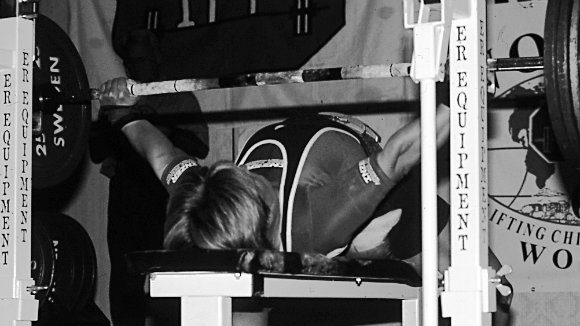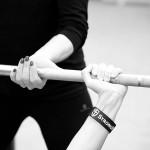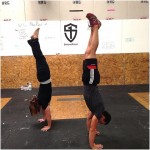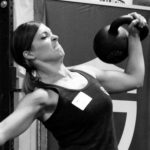The contenders for the “baddest” press title are:
- Kettlebell military press
- Barbell military press
- Handstand push-up (wall supported)
- One-arm push-up
- Parallel bar dips
- Barbell bench press
The Kettlebell Military Press
The kettlebell military press is the healthiest in the line-up, thanks to its shoulder mechanics. Its downside is, it demands a high volume of training to keep moving. There are men and women who have succeeded in pressing a heavy kettlebell or a pair of them on a low volume regime, but they are an exception, rather than the rule. Usually it takes 50-100 weekly reps to keep progressing.
The barbell military press has the same strike against it. As Russian weightlifters used to say when the press was a part of the competition, “To press a lot you must press a lot.”
The Handstand Push-up
The wall supported handstand push-up, although in the same volume-hungry vertical press category, is a strong contender. What makes it different is its pseudo-machine quality. Not having to balance the weight and sliding up and down the wall allows you to handle a relatively heavier weight. (If your 1RM military press is equal to your body weight, you will have no problem knocking off sets and reps of handstand push-ups and not having to lift your forearms is only a small part of the explanation.) This translates into quicker gains.
Because you can do handstand push-ups anywhere, the drill enables you to “grease the groove,” which means the volume is no longer bothersome and you do not get too tired to do other things. Of all the drills on the list, the handstand push-up trashes the glutes the least, which is another asset. A strong contender indeed.
The One-Arm Push-up
The one-arm push-up seems like the logical winner. It provides the opportunity to grease the groove. It addresses a whole lot of symmetry and reflexive stability issues, which is one reason Gray Cook is a fan of The Naked Warrior. It teaches high tension skills. In addition to working the “pressing muscles,” it devastates the midsection.
The last item is an asset and a liability. When your pressing muscles get strong enough for you to knock off multiples sets of five, one-arm push-ups beat up your your abbies, glutes, and QL a lot more than your triceps. Which is why the one-arm push-up does not win this contest.
Note: If your choice of a press has to be body weight, it is a good idea to rotate one-arm push-ups and handstand push-ups every two weeks.
That said, every strength athlete must go through the one-arm push-up school. The tension and linkage lessons the drill teaches are priceless. One of my students, a U.S. military special operator, practiced one-arm push-ups exactly as taught in The Naked Warrior on deployment and did not touch a pull-up bar. When he got back stateside, he was able to do a one-arm pull-up.
The strength skills gained through one-arm push-ups can later be applied to a great number of lifts and athletic skills. When you own it, periodically test your ability to do it. The same applies to the bodyweight-only pistol. Gray Cook has taught me that both make effective assessments. If you are strong, yet cannot do one or both of these drills, you have some dysfunction that needs to be addressed.
The Bar Dip
Parallel bar dips are next on the list. If your shoulders can take them—a big “if”—this exercise is a good choice because it allows you to use very heavy weights. That translates to great strength gains.
Not having to stabilize the spine makes dips easy on the nervous system and quick to recover from. Yuri Vlasov loved dips as an opportunity to unload the spine—every other press loads it. (Properly done dips must be done in a hollow position. I will ask Geoff Neupert, Master SFG, to write a blog on this topic in the future.)
If more shoulders could take the dips, they might have won.
The Bench Press
That leaves us with the bench press (barbell, naturally). The last man standing, it wins.

The bench press has a long record of building unbelievably strong upper bodies. Its invention was a strength game changer. Which is why serious power athletes have been benching, are benching, and will be benching. They are not impressed with the “non-functional” rhetoric. They do what works.
The bench is so effective because it involves a great many muscle groups, enables one to handle very heavy weights, and does not present stabilization or coordination challenges. A great plus is that the bench press can thrive on a very low training volume.
Bench strength carries over very well—provided your hips and shoulders are flexible and your midsection is strong. In other words, a few prying goblet squats, hip flexor stretches, and heavy get-ups will make your bench press strength count.
In the next issue of this blog, in addition to nominating the “best” upper body pull, I will explain why I did not subdivided presses into “horizontal” and “vertical.” Meanwhile, ignore the sissies with their “non-functional” rhetoric and bench away.
Be strong first.





I find straight bar dips to be a lot easier on the shoulders than parallel bar dips. Simply touch your chest to the bar on each rep and otherwise try to keep your body off of the bar as much as possible. Most people find them a bit harder too – keep your legs straight and feet out in front of you to help counterbalance your body as you dip.
As for the one arm push up, the harder you flex your entire body before you engage in and throughout the press, it becomes easier to handle in the body and, in fact, allows you to focus more on the actual pressing. It’s all about rigidity and trying to avoid letting the torsion that builds in the body pull your body off center…but admittedly it is hard to do exceptionally clean one arm push ups for reps, yet it’s easy to let your form slip and not even notice.
Would One Arm Pushups on knees solve the “smoke your glutes + abs” liability? (As Vin Van Diesel did in one of his movies … )
I personally don’t think it’s worth doing that exercise on your knees because although it will be easier, it will likely be of limited application to the full one arm push up. Instead, try it with your hand on a higher elevation than your feet to more closely imitate the full exercise. That or try slow one arm negatives.
I think that the barbell press is useful. because it is easy to scale it. Whereas handstand pushup are highly technical and not so easy to adjust, but on the other hand they develop more stabilising muscles.
This is an interesting piece. I appreciate your work, Pavel. I am not familiar with some of the mechanical reasoning you used, though. How would the mechanics of a two handed push up with added weight across the scapula measure up against the other exercises?
where would the bent press lie in all this?
I was asking myself the same question! And about the floor press too. Why ignore the 2 choices from PTTP?
I would think the bent press would be rated between a BB press and OAP on a list of overall utility. It has somewhat limited loading potential but is tremendous as a full body lift and coordination+control stimulus. Its choice for PTTP was most likely due to its ability to completely complement the deadlift. But it simply cannot compete with the Bench or with PB Dips, in terms of basic pressing strength development. Just not enough loading. And it could be said that the bent press is almost equal parts full body lift and press.
The Floor Press probably turns out in the end to be equal in quality to the Bench. Larger loads, safer on the shoulders, but sacrificing precious ROM. The Floor Press was the original Bench, and I feel the two are easily substituted with one another.
Regardless of any of
I would have to say dips or dumbell military press. I do like handstand pushups also. For meat heads that say handstand pushups are stupid, try doing it 1 handed or 1 arm assisted. Bench pressing is ok , I have nothing against benching but it’s not as functional as the overhead press or handstand pushup
Handstand pushups have given me best results because my lifestyle doesn’t allow me to bench regularly. I’ve seen excellent carryover from HSPU to bench press but not so much the other way round. Obviously many stabilizer muscles trained in HSPU benefit the bench but the bench using far fewer has less carry over. I have no doubt bench press will pack on more muscle given it’s possible to move a lot more weight and stimulate the pectorals more effectively.
@ aaron hall:
Take a look at Rippetoe’s treatment of the bench in Starting Strength. He addresses shoulder issues and the way to prevent them (a slight shift of the elbows toward the feet at the bottom to save rotator cuffs).
Look on the interwebs and you’ll find that most exercises are bad for you because so few people pay the studious attention to technique that is deserved by the exercise. Mainstream results are not an indicator of the efficacy of the tool.
So Bruce. A punch is just a punch.
Hello Pavel , I’m Italian, I do competitive boxing, I wanted to ask a daily program to turn my shoulders in steel, I’m not afraid of hard work to do, I ask you because I do not care inflate my back like in bodybuilding, but I want to turn them into steel but i don’t want lost my speed shoulder !! please answer me
Matteo, if you are not afraid moving up a weight class, bench presses are great. Add kettlebell get-ups.
Pavel,
I’m an amateur boxer. My goal is to increase punching speed and power.
So far I’m using KB MP for this. Although speed and power have improved, I find that the high volume needed to further improve now starts to conflict with the high volume of punches in boxing.
My shoulders take bar dips very well. Would changing to a lower volume strength program based on bar dips be a better choice? Or is the different angle of bar dips less favourable for development of the muscles needed for punching?
Daniel, it is likely to work well. To clarify—this will build a foundation of general strength; your boxing practice will build speed and power on its foundation.
Pavel, thanks. I tried and was able to gain a lot of additional strength in the last weeks. Punches got faster and harder again and even my KB press went up without any direct exercise.
Thank you Chairman Pavel, for listing all the various presses and outlining the pros and cons.
Between the kettlebell military press and the barbell military press, which is the better exercise for building shoulder (specifically deltoid) armor/size? I’m in the early stages of the 40 day plan as outlined in Easy Strength, hoping to stick with one of those for the pressing component.
Tim, very comparable. The KB press is more shoulder friendly; the BB press allows small weight adjustments which come in handy in the ES protocol.
Nice, thank you very much. Also, Happy New Year!
Pavel, I’m a big fan of “Naked Warrior”. Should I focus on my KB press, which has improved, or concentrate on my One arm pushups. I’m a construction worker ,and a martial artist. Thanks!!!
John, there are many options. One is pressing 3/week alternating the two.
I’ll try it. Thanks, and Happy New year to You and Your Family!!!
To Pavel,
Just a Fitness instructor at a Gym for a few years and a Recreational Martial Artist.
I expected hands down the overhead press to be number 1. Reading many views youve expressed before about bodybuilders having strong Benchs but not having the core strength for overhead pressing. So I was surprised you mentioned Bench Press as the Number 1.
Aaron, the list was made for competing athletes from non-lifting sports. While the KB MP is, in my opinion, the healthiest press there is, it demands a high volume of training and significant energy expenditure to improve. A fighter or a hockey player has too many skills and qualities to work on to afford such an investment.
For a recreational martial artist such as yourself and for your fitness clients the KB MP is a great choice.
Russian experience shows that with proper technique and symmetry and moderate volume the bench press is very safe—at least until you get into competitive powerlifting poundages.
You are correct that the bench does not strengthen the trunk stabilizers in the manner of the BP. Which is why an athlete who benches must address it in other ways—such as the full contact twist.
To Pavel,
Ye, ive looked at the negatives of the Bench and not really looked at the Positives. Also didnt realise the list was the focus for High Level atheletes who needed some strength work.
Bench Press got say I shocked by this.
Bench pressing with a Bar and its restricted movement of the scapular which often leads to injury. Granted most injuries with Bench press tend to be down to lack of shoulder flexibility and mobility and bad form. But still dont think Ive ever come across an exercise that leads to such shoulders injuries.
Not to mentioning Bench press doesnt give the strength in the stablizing muscles as a standing overhead press say.
Shocked!
Aaron, may I ask what is your athletic and coaching background?
Our findings are consistent with yours. In addition to the low volume, we’ve also migrated the large majority of our bench pressing reps to a close/medium grip and have seen a reduction in shoulder/elbow related injuries. Low volume/high frequency has worked well for us.
Great stuff as usual.
And still, I see the TGU is seen everywhere as a magic potion for pressing…
TGU’s with (very) heavy weights would still be my favorite. Try pushing al that meat and iron to a top position in a flawless movement. Damn raw impressive pressing strength I say. I can’t do it (yet).
Great articles! I enjoy the dead stop version of the bench press. Basically pressing from a dead stop in the bottom position from pins. Has anyone had experience with these and are they hard on the shoulders over time?
Jason, there are a lot of ways to bench press from a dead stop, including letting the bar sink into your chest and getting almost a bounce as you start it upwards with a heave of your chest. It can be a competitive approach to bench pressing on its own.
If, OTOH, as you’re suggesting, you press off the pins in a rack, I haven’t tried that nor have I heard it discussed before – squats off the pins in a rack, yes, but not the bench press. I wonder why that is? It would be interesting if you’d take a video of yourself doing this and post it, as well as let us know what sort of percentage of 1RM you use when you do this.
You’d probably gain more limit strength by practicing negatives rather than “dead stop” concentric maneuvers. Although perhaps it’s also a great way to improve strength out of the deepest/sticking point of the bench.
No clean & press in sight?! That would get my vote.
Great series Pavel. Looking forward to the pulls.
Carl, no highly technical exercise has made the list.
A colleague of mine e-mailed me: “Interesting choice in “bests” today. I agree that it makes one strong, but what do you think about all the shoulder injuries that go along with it? Not to mention the shoulder mechanics – having to pin the scapulae in retraction and depression and changing the scapular humeral mechanics…”
Making a “best of” list is a contentious enterprise but one that stimulates thinking.
My answer: experience shows that if one develops the proper mobility (lateral arch), strong scapular retractors and technique (pulling the bar down, tearing it apart, using the lats, etc.) and keeps the volume low, the BP is not hard on the shoulders.
Add a few get-ups and arm bars and be strong and healthy.
For those of us not built to bench – and that includes me – another option is to do it, anyway, and just live with whatever numbers you get. After about six months trying to bench press about 7 years ago, I’ve been back at it of late and am making slow, steady progress.
I’m not saying everyone needs to bench – “best” press doesn’t mean “only” press or anything like that. But, so far, I am enjoying the ride and feeling like it’s doing good things for me.
My own training right now has me hitting dumbbell bench press once a week and barbell bench press once a week – the DB BP is great because it lets you work an increased ROM and, for someone of my build, that’s where I”m weakest.
Steve, agreed. One point of my original post was that even if you aren’t built to do full-range benching safely, you can do partials in a rack or otherwise.
I ain’t making this up. I’ve never used my build as an excuse not to squat … but if I lower a bar all the way to my chest, my shoulder capsule is stretched to an incredible degree. If I had to compete in powerlifting on threat of gulag, I’d start working on a really high arch stat.
On the other hand this anatomical setup makes for great overhead pressing and punching power/reach.
The highest arch you can manage is definitely a requirement for competitive PL bench pressing. I wish my back bent more than it does. It is one of my issues that I can only work on so much because of my particular back.
The thing I like about the DB BP is the extneded range of motion, and I use it as a warmup for regular benching – it helps open the chest and that’s where you’d have to get your ROM from, opening the rib cage to spare your shoulders.
Rob, you might find that if you force your chest up to meet the bar and pull the bar down not only with the lats but also the posterior delts, your shoulders would not object.
After a few shoulder surgeries I find the groove of the KB military press more forgiving than the barbell version, attention to detail , staying tight, (the eccentric is never passive) pressing off the lat shelf etc and a few post press getups keep my shoulders as healthy as they are ever going to be. I press almost daily keeping the volume relatively low alternating between heavy tight grinds, push press and floor press.
Nick, there is little doubt that the single KB MP is the healthiest on the list.
I thought the bench press was your least favourite. Why the change of heart? And no mention of the floor press. dumbbell or kettlebell.
Ian, in the days when bodybuilding was the prevailing training model, the BP created more problems than it solved. Todays, when “functional weakness” reigns, circumstances have changed enough for me to change my mind.
Note that the BP will do you little good unless you develop lower body power, a strong waist, and flexibile hip flexors.
Useful information. Lucky me I found your web site by accident, and I’m stunned why this coincidence did not took place earlier! I bookmarked it.
Or I could do a crazy back arch or wide grip like Svetlana there.
My only comment would be that if you are not built to bench well, don’t do it or modify the exercise. I have long forearms and short upper arms — makes me a good KB presser but a lousy bencher because it’s so difficult to get depth without stretching and injuring the shoulder capsule. If I wanted to start benching seriously to strength, I’d do partials. But that would just be training. You can’t compete using partials obviously.
If you have poor leverages for the bench press, try close-grip bench presses with heavy chains. This will unload your shoulders in the precarious bottom position (bar at chest) and add a lot of resistance toward the top of the movement, where the angle of the movement is more favorable. This way you’re still building some strength in that all-important bottom range, but the risk of injury is virtually nonexistent.
Partial presses are okay, but don’t really have the strength building potential of full range presses. Bench pressing from the bottom position (off pins) should work well in theory, but in practice it was the only pressing movement to ever cause me severe shoulder pain.
Building up your upper back will contribute to a shorter ROM necessary to go from the chest to lockout. It also has the added benefit of making you look (more) awesome.
I like all presses, but the BP is king IMO. Incline and military front press would tie for second place.
Good choice sir, great series so far.
Amen! Pressing has always been my weakest link. Nothing more gratifying than low rep, high bar speed sets of chain bench presses on an power-focused day, followed by a new PR press a few days later. Thanks Pavel!